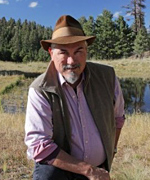 —Alan Dulaney
—Alan Dulaney
In central Nevada, farmers are running up against the problem that faces irrigated agriculture across the West: groundwater is a finite resource, and it is declining due to over-pumping. In a recent article, Daniel Rothenburg described the situation in detail.
As much of Arizona agriculture used to be, the farmers of Diamond Valley in Nevada are highly dependent upon groundwater for irrigation. Without irrigation, farming cannot succeed; with irrigation, agriculture has expanded across the valley, which is similar in size to major Basin and Range valleys in Arizona. The underlying aquifer is also large, but many wells have been constructed into it since the 1960s. Water levels in wells have been dropping, and the declines are causing concern amongst most farmers who can foresee an end to irrigation with groundwater.
Nevada water law lacks anything as comprehensive as the 1980 Groundwater Management Act in Arizona. The Groundwater Management Act capped irrigated acreage in Active Management Areas (AMAs), defined groundwater withdrawal rights, mandated safe-yield goals by 2025, and encouraged the used of replenishable sources such as Central Arizona Project water.
The Diamond Valley lacks major replenishable sources. Nevada water law allows groundwater allotments based on the doctrine of prior rights. The enforcement mechanism is mandatory curtailment of pumping for junior right holders. And over the years Nevada issued far more water rights than could be supported by the water physically available. Nevada did pass legislation in 2011 which allowed definition of Critical Management Areas, where local interests could define conservation plans and voluntary reductions in pumping. Under that law, Diamond Valley was deemed a Critical Management Area, and local farmers came up with a local plan for reductions in groundwater pumping over time.
Not everyone climbed onboard. This is where the doctrine of prior rights became an obstacle, because the most senior right holders demanded that other farmers cease pumping altogether so that senior rights would be honored in full. Most farmers in Diamond Valley would go out of business without any groundwater to irrigate their lands. And that land would rapidly become worthless. Nevada courts upheld senior right holders’ claims.
Part of the 2011 Nevada law mandates that local plans lead to reductions in pumping by 2025. Otherwise curtailments will be enforced against junior right holders. Irrigated agriculture will disappear in Diamond Valley unless senior right holders join in the local water governance effort. It is not clear that they will, given court victories.
Arizona faced this issue long ago, but had an alternative not available to the isolated Diamond Valley. Real estate developers, hungry for land, bought out farmers in the AMAs and replaced irrigated agriculture with subdivisions that use less water. Irrigated agricultural acreage has declined markedly in the Phoenix and Tucson AMAs. While irrigation (both surface and groundwater) is still the basis for agriculture in the Pinal AMA, developers have already purchased large swaths of the land, leasing it back to farmers whilst waiting for population growth to make subdivisions profitable. However, continued groundwater pumping has lowered water levels to the point where such future real estate development is now threatened by lack of physical availability under the Assured Water Supply program—but that is a problem already being worked on. No one wants to see Pinal County land become worthless.
The collision of old water law (prior rights) and hydrologic reality (over-pumping of the aquifer) in the Diamond Valley of Nevada illustrates how important water policy is for the economic future of large regions of the West. As warmer and drier conditions persist, the time available to sort out these conflicts and come up with acceptable concepts on managing demand grows short. For central Nevada, 2025 looms as a watershed year, in which irrigated agriculture could collapse permanently, or continue along a course that will look very different.